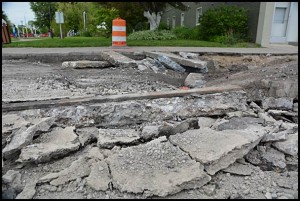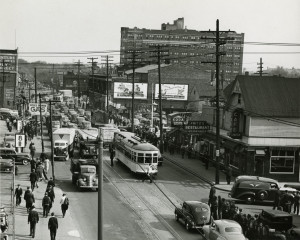Under Jos. Campau, a view of the city’s street car past
By Charles Sercombe
Every now and then parts of Jos. Campau are torn up for repairs.
A number of years ago it was for repaving part of the street.
Lately, the sewer line project in the southend has ripped up Campau.
In both cases, a glimpse of the city’s past was exposed. Rail lines that were once used by streetcars could be seen in both cases, which reminds us that at one time streetcars were the major source of transportation not only in Hamtramck but the metro area as well.
From all reports from back then, it was a fantastic system.
As the story goes, that all went away by the 1950s when cars were made king of the road. Goodbye streetcars, hello autos and, ugh, buses.
There are many who lament the passing of streetcars, and now Detroit officials are working to bring back a rail line on Woodward. You could say what’s old is new again.
We asked local historian Greg Kowalski, who is also the chairman of the Hamtramck Historic Committee, to reflect on Hamtramck’s era of streetcars. Here’s what he had to say:
“We were mainly served by the Baker Streetcar line. Originally, that ran up Jos. Campau from downtown Detroit to about where the viaduct is today. Later, it was extended to run through Hamtramck to about Davison.
“There were connectors all across the metro area. Some people who lived here worked at Henry Ford’s Rouge plant and would take the streetcars from here to there by using connectors.
“The lines that came here were established in the early 20th century – about 1905. They were a primary form of transportation. They weren’t very comfortable but they were cheap and reliable. And they were critical for people to get around.
“Most people didn’t have cars until after World War II so they needed the streetcars to go any distance. The system was shut down in about 1955 when the new bus system was installed. I think just about everyone today agrees that was a mistake. There is still controversy about that. Some people say that the auto makers were responsible because they didn’t want that form of public transportation, which competed with motor vehicles.
“I had my doubts about that until I met a former auto exec up in Bloomfield Hills who said he was at a meeting with the city of Detroit back in the 1950s and confirmed that it was true.
“Their loss really didn’t hurt commerce locally because we are a very walkable community and the buses did provide a good alternative to bring people in from outside. And cars were becoming far more common in the mid-1950s. But there is a lot of nostalgia associated with the streetcars. My mom, who died in 2013 at the age of 90, told me one of her earliest memories was falling asleep in her mother’s arms while hearing the clanking sound of the streetcars in the distance.”
Want to see part of Hamtramck’s streetcar history? At the city’s Historical Museum, located at 9525 Jos. Campau, there is a section of a streetcar track on display. The museum is open 11 a.m. to 4 p.m. Saturdays and Sundays and by appointment. Call (313) 893-5027.
Sorry, you won’t be able to see any of those old streetcars since they are long gone, shipped off to Mexico many years ago.




Ronald Richards
December 6, 2019 at 1:31 pm
When we moved to the East side by east grand and Milwaukee we would go back to the west side on the Baker I don’t remember if the line went all the why to Vernor and Springwells then we walked down to Springwells and Lafayette
Georgia Gubbels
June 23, 2023 at 4:53 pm
I remember riding on the streetcar with my mom in Hamtramck when I was young and we lived in Hamtramck in the 1950s. It was a thriving city back then. My mom worked at the Dodge factory at night to save money for a down payment on a house and my dad worked at Michigan Bell in Highland Park until he was tragically killed in 1972. We had moved to Redford MI in the early 1950s.